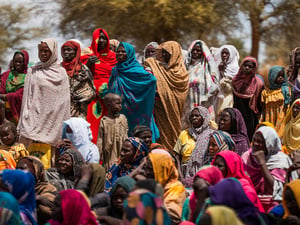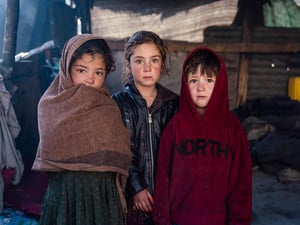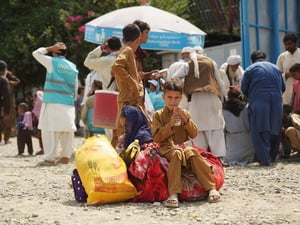Afghan returnees facing problems in home districts seek safety in Kabul area
Afghan returnees facing problems in home districts seek safety in Kabul area

Mud bricks dry on the ground in the Pul-i-Charkhi neighbourhood. Families have been building new homes after fleeing to the area to escape insecurity in other areas.
PUL-I-CHARKHI, Afghanistan, February 4 (UNHCR) - A large pale green safe takes pride of place in the house that Rulhallah has recently built in the Pul-i-Charkhi district just east of Kabul. It is one of the many items he brought back from Pakistan in 2008, along with hopes of rebuilding his life in safety and dignity after years of enforced exile.
He is still optimistic about the future, but not in his home district of Tagab in the central province of Kapisa. He returned there initially from Pakistan but fled to Pul-i-Charkhi after only five months because of fighting between government forces and anti-government elements, which left two of his relatives dead.
"We want to stay here because we are not hopeful that security will improve in our home village," Rulhallah told recent UNHCR visitors to his home. His feelings are shared by many others, including refugee returnees, who have fled renewed conflict in their home districts and sought shelter in and around the Afghan capital.
Some have set up spontaneous communities on government-owned land, like the 200 families (1,500 people) in Pul-i-Charkhi, while an unknown number of others are believed to be staying with relatives or renting rooms. UNHCR, which monitors the situation and provides aid, has firmly identified some 2,300 displaced civilians living in the Kabul area, including those in Pul-i-Charkhi.
Such large population movements have the potential to cause tension between the displaced and others. In the case of Pul-i-Charkhi, local landowners were unhappy after the first internally displaced people (IDP) from Tagab began arriving some five years ago. They told the new arrivals to leave.
But talks between the elders and officials, facilitated by UNHCR, have led to a situation where the community is tolerated, though not officially sanctioned. Over time, more people have joined the group from Tagab and other areas.
Despite having no legal right to live there, many of them, like Rulhallah, have invested heavily in their new homes with savings brought back from Pakistan.
Rulhallah's house is part of a family compound that he and his wife and seven children share with his brother and uncle. He has electricity and well water.
The settlement they live in sprang up in late 2004, when the first group of Afghan civilians arrived from Tagab, where security had deteriorated, schools were routinely closed and there were few economic opportunities.
Most had returned to Afghanistan that same year from the New Shamshatoo refugee camp in Pakistan. "Things looked much better [in Afghanistan at the time] and we thought there would be more development and better security" in Tagab, recalled an elder, Wazir Mohammed.
Now he and others from Tagab are once more uprooted and part of a larger urban drift in Afghanistan, with the forcibly displaced living among others who migrate for economic reasons. The capital's population has swollen in recent years to an estimated 4.5 million people from some 1.5 million in late 2001.
"Internal displacement patterns are becoming more complex in Afghanistan. In the cities, it is very difficult to distinguish IDPs from poor rural migrants or the urban poor," said Ewen Macleod, UNHCR's representative in Kabul. "UNHCR's principal support is for those who are forcibly displaced by conflict. But whenever there are pressing humanitarian needs within mixed populations of IDPs, migrants and squatters, we seek the engagement of other relevant agencies."
Meanwhile, the IDPs in Pul-i-Charkhi continue to invest in their housing and believe in the future. "If we go back to our place of origin, we will not have a dignified life," said elder Said Khassim, while adding that most of the children in the settlement attend school.
"We don't want our children to be used by anti-government elements or by those who want to do bad things to our country. We want them to be educated so they can make the right decisions. Here at least, they have access to education."
While grateful for the help received by UNHCR, he and other elders noted that the men of their community were doing their best to earn a living. Many of the IDP men here work for most of the week as daily labourers in the nearby bazaar.
Rulhallah has more ambitious plans. He takes the UNHCR visitors to a tiny room crammed with auto parts brought from Pakistan. He plans to start a spare parts business, reviving a livelihood he forged during his years in exile.
"In Pakistan, I built a similar house and invested a lot, even though I knew that one day the Pakistan government would force me to leave. This is my country. It is my own land, and that is why I invested. I am hopeful that the government will allow us to stay," Rulhallah said.
By Ariane Rummery in Kabul, Afghanistan








